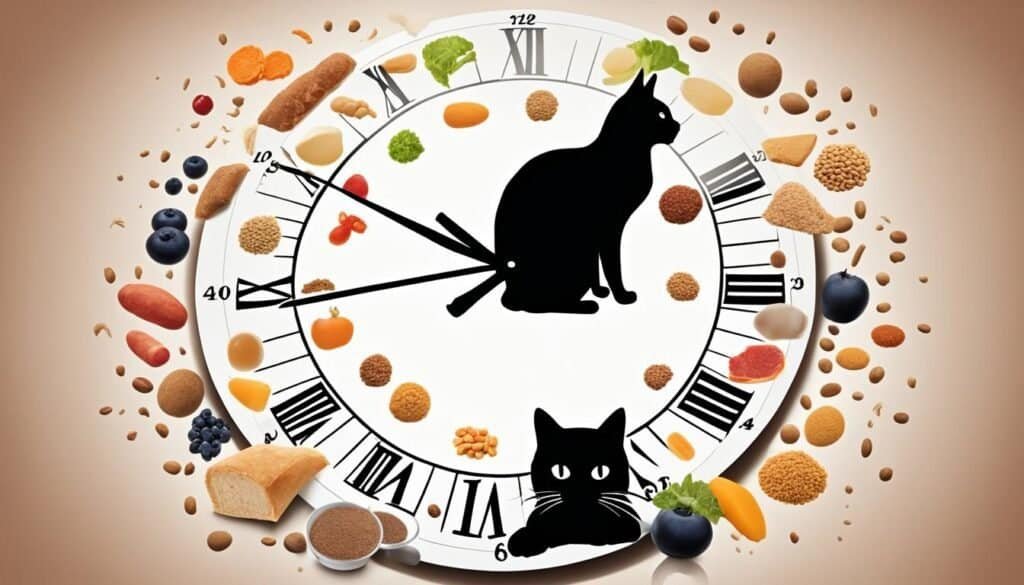Feeding your cat on a regular schedule is crucial for their health and well-being. Cats are creatures of habit and thrive on routine. Establishing a consistent feeding schedule provides them with security and predictability. Not only does it help maintain their overall health, but it also prevents hunger-induced behavior issues and allows for proper digestion.
Key Takeaways
- A cat feeding schedule is important for maintaining the health and well-being of your feline friend.
- Feeding an adult cat at least twice a day, with meals spaced 8-10 hours apart, is recommended for proper digestion.
- A regular feeding schedule makes it easier to transition to a new food if needed.
- Monitoring your cat’s eating habits can serve as an early indicator of potential health problems.
- Consult with a veterinarian to determine the optimal feeding schedule based on your cat’s individual needs.
Setting a Feeding Routine for Kittens
When it comes to feeding kittens, a structured feeding routine is essential to ensure their optimal growth and development. Kittens have different dietary needs compared to adult cats, and they require more frequent meals throughout the day. By following a proper cat feeding schedule, you can provide your kitten with the necessary nutrients and energy to fuel their growth.
It is recommended to feed kittens up to six months of age three meals a day. This allows them to receive a consistent supply of nourishment that supports their rapidly developing bodies. By having regular meals spread out throughout the day, you can give your kitten the fuel they need without overwhelming their small stomachs.
As kittens mature and reach adulthood, their feeding schedule can be transitioned to two meals per day. At this stage, providing two well-balanced meals will be sufficient to meet their nutritional needs. However, it is crucial to keep in mind that each kitten is unique, and their specific needs may vary based on factors such as breed, size, and overall health.
Consulting with a veterinarian is crucial for establishing a cat feeding schedule that is tailored to your kitten’s specific requirements. They can provide personalized advice based on your kitten’s age, breed, and overall health condition, ensuring that they receive the appropriate amount of food on a regular basis.
Remember that setting a consistent feeding routine for your kitten not only supports their healthy growth and development but also helps in establishing good eating habits that will benefit them throughout their lives.
Creating a nurturing environment for your kitten includes offering them the right nourishment at the right times. By following a structured feeding schedule, you can ensure that your kitten receives the necessary nutrients for their overall health and happiness.
Factors Affecting Feeding Frequency
The number of meals a cat should eat each day depends on various factors, including their age, health status, and individual preferences. It is important to consider these factors when establishing a cat feeding schedule to ensure your feline companion’s optimal health and well-being.
For adult cats, the general guideline is to provide two meals per day, spaced 8-10 hours apart. This feeding schedule allows for proper digestion and prevents hunger-induced behavior issues. However, it is essential to note that some cats may require more frequent feeding.
Cats with medical conditions such as diabetes or hyperthyroidism may benefit from more frequent feeding. For these cats, it is crucial to work closely with a veterinarian to determine the optimal feeding frequency based on their specific needs. Your veterinarian will consider your cat’s condition, medication schedule, and overall health to establish a feeding routine that supports their well-being.
Additionally, individual preferences can play a role in determining feeding frequency. Some cats simply prefer smaller, more frequent meals throughout the day. Observing your cat’s behavior and appetite can offer insights into their feeding preferences.
Taking these factors into account, it is essential to strike a balance between providing regular meals and accommodating your cat’s health and individual needs. By working with your veterinarian, you can establish a feeding frequency that promotes optimal nutrition and satisfies your cat’s unique requirements.
Image:
Choosing the Right Type of Food
The type of food you choose for your cat can have a significant impact on their feeding schedule. There are two main types of cat food: dry food and canned food.
Dry food: When complete and balanced, dry food can be left out for cats to free-feed throughout the day. This means that you can provide a bowl of dry food that your cat can access whenever they feel hungry. Free-feeding with dry food allows cats to graze and eat at their own pace. However, it is important to monitor their intake to prevent overeating and obesity. Measure the appropriate amount of dry food and refill the bowl accordingly to maintain portion control.
Canned food: Canned food is typically fed as specific meals or portions. It offers the benefits of increased moisture content and palatability, making it a delicious and hydrating option for your cat. Canned food is often recommended for cats with specific dietary needs or health conditions. It is usually served at scheduled meal times, providing your cat with a more structured feeding routine.
Combining both types: Some cat owners choose to combine both dry and canned food in their cat’s feeding schedule. This involves providing dry food for free-feeding throughout the day and offering canned food as scheduled meals. This approach provides the nutritional benefits of both types of food while allowing for the convenience of free-feeding. However, it is important to adjust the portion sizes accordingly to maintain a balanced diet and prevent overeating.
When deciding on the right type of food for your cat, consider their individual preferences, dietary needs, and any specific health conditions they may have. Consult with a veterinarian for personalized feeding recommendations to ensure that you are providing the best nutrition for your feline companion.

Implementing a Cat Feeding Schedule
Establishing a feeding schedule for your cat is crucial for their health and well-being. Consistency and dedication are key when implementing a cat feeding routine. Here’s a step-by-step guide to help you get started:
- Determine the optimal number of meals: Assess your cat’s age and health status to determine how many times a day they should be fed. For most adult cats, two meals per day are recommended.
- Create specific meal times: Set designated meal times for your cat and stick to them as closely as possible. Consistency is important to establish a routine that your cat can rely on.
- Avoid free-feeding: Resist the temptation to leave food out all day for your cat to graze on. Free-feeding can lead to overeating and weight gain. Instead, provide measured portions at meal times to control their intake.
- Utilize food puzzles or interactive feeders: Consider using food puzzles or interactive feeders to provide mental stimulation and slow down your cat’s eating. These can make meals more engaging and prevent them from eating too quickly.
- Provide fresh, clean water: In addition to regular meals, ensure your cat always has access to fresh, clean water. Hydration is important for their overall health and well-being.
By implementing a cat feeding schedule, you can provide structure and routine to your cat’s daily life. This promotes their overall health and helps prevent obesity and related health issues. Remember to consult with your veterinarian for personalized feeding guidelines based on your cat’s specific needs.

Conclusion
Establishing a cat feeding schedule is essential for maintaining your feline’s health and well-being. Cats thrive on routine and predictability, and a regular feeding schedule provides them with security. By feeding your cat at consistent times and with measured portions, you can prevent overeating, obesity, and associated health issues.
It is important to consult with your veterinarian for personalized feeding guidelines for cats based on your cat’s specific needs. They can provide valuable insights into your cat’s nutritional requirements, taking factors such as age, weight, and any existing health conditions into consideration.
With a well-planned feeding schedule, you can ensure that your cat receives the proper nutrition and enjoys a happy, healthy life. Remember to monitor their eating habits and make adjustments as needed. By providing your cat with a consistent routine and the right amount of food, you are contributing to their overall well-being and promoting a strong bond between you and your feline companion.
FAQ
How often should I feed my cat?
How many meals a day should kittens have?
Can cats have more frequent meals?
What type of food should I choose for my cat?
How do I establish a feeding schedule for my cat?
Why is a feeding schedule important?
Last modified: February 26, 2024













